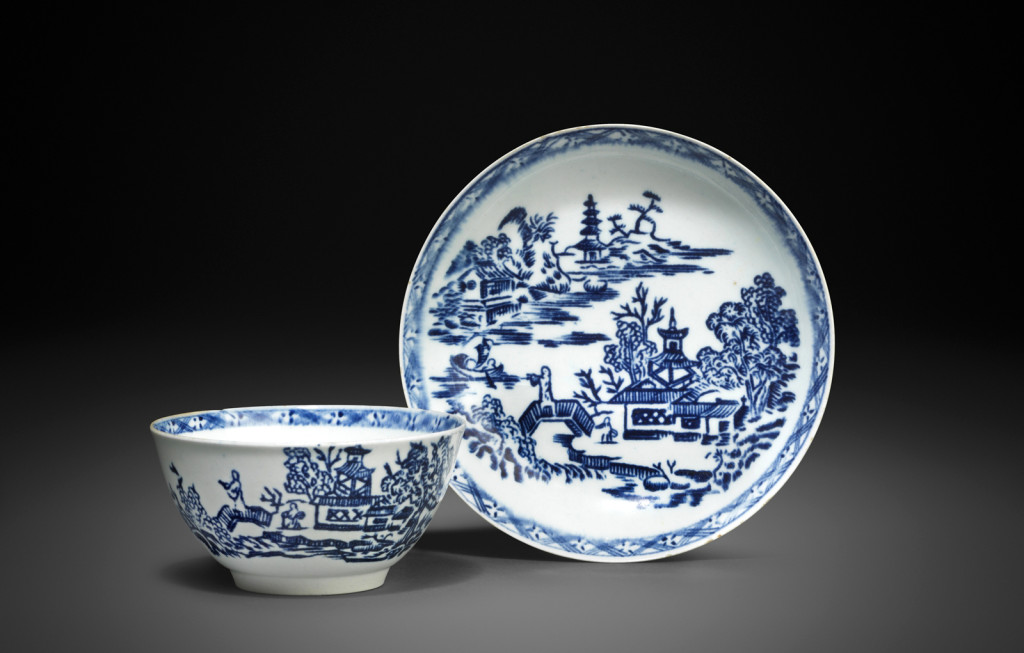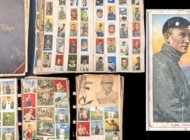SALISBURY, ENGLAND — A tea bowl and saucer attributed to John Bartlam — representing the eighth and ninth recorded pieces of the earliest porcelain made on American soil — sold in a post-auction sale at English auction house Woolley and Wallis following the firm’s February 19 Fine Porcelain and Pottery auction. It sold for $65,227 to an American buyer acting through an agent.
The pair features the maker’s Man on the Bridge pattern, which depicts a solitary figure standing on a small bridge linking pagoda islands. The tea bowl’s interior features a small vignette of a hut beside a tree. Woolley and Wallis believes these pieces to be from a matched tea service that reached England in the late 1760s or 1770s.
This latest sale comes on the heels of a blockbuster result a year earlier in February, 2018, when Woolley and Wallis sold a Bartlam teapot for a record $806,000 above an estimate of $13/26,000. The teapot was bought by the Metropolitan Museum of Art.
Records indicate that John Bartlam produced ceramics in Lane Delph, Staffordshire, as late as 1761. He is known to have settled in Cain Hoy, South Carolina, around 1765. Bartlam would use the area’s kaolin, then known as Cherokee clay, to produce his porcelain.
In May 1767, correspondence from English producer Josiah Wedgwood is thought to identify Bartlam, saying, “I am informed they have the Cherok[ee clay] to a Pottwork at Charles Town.” Around the same time, another piece of Wedgwood correspondence relates to how Bartlam could create and decorate porcelain, a medium he is not thought to have mastered at the time: “[we] have at this time among us an agent hiring a number of our hands for establishing new Pottworks in South Carolina: having one of our insolvent Master Potters there to conduct them.”
The auction house states that the “Man on the Bridge pattern…is recorded at several English factories. The pattern here most closely resembles that of the London factories and, given the skill of the engraver, it is likely that Bartlam had employed an English decorator who had previously worked for one of these concerns.”
Reached after the sale, Clare Durham, Woolley and Wallis’ associate director and head of European ceramics and glass, told Antiques and The Arts Weekly, “I appreciate that the price of $65,227 seems ‘disappointing’ following the stratospheric result of the teapot last year; however, in hindsight, I think we placed too much stock on its condition (which was very good) and the fact that it is the only matching tea bowl and saucer. In fact, these pieces are so rare and esoteric that condition (as we saw with the teapot) seems to be all but irrelevant.”
She added, “The slight reluctance, if you can call it that, has been that the collectors and institutions that want a piece and have pockets deep enough already have a tea bowl and/or saucer. Added to which, the pattern on these did not match any of the excavated sherds. That’s not to say that anybody doubted it — the science is there as well as the connoisseurship — but the shape and pattern were just not enticing enough to encourage higher bidding.”
On whether Bartlam’s bubble has burst, Durham remarked in the negative. “I really don’t think it [has],” she said.
Since the result of the teapot last year, Durham confirms that the auction house has been approached with a variety of blue and white pieces that are “odd,” in her words. On these, she said, “some of [them] have been completely discounted, some of [them] have been tested and discounted, and some of [them] are still undergoing research.”
Durham left us with a cliffhanger, “it is possible that a tenth piece of Bartlam has been identified.”
For more information, www.woolleyandwallis.co.uk or +44 (0)1722 424500.





